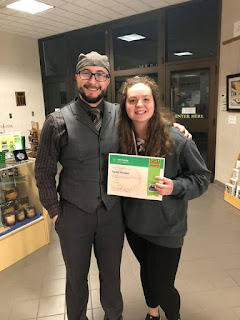 |
| Principal David Swank |
“If we are really thinking about changing outcomes for students, then the Oceti Sakowin Essential Understandings and Standards need to be at the leading edge of our discussions about instruction, materials, and strategy,” Swank says.
Having said that, Swank is the first to admit he and his staff don’t have it all figured out: “It’s really required some vulnerability from our staff because the majority of our staff are non-Native, so there has been some trepidation about not wanting to do things incorrectly and not wanting to offend people.”
Just start
Roughly 40 percent of Canyon Lake students identify as non-white and most of those non-white students identify as Native American.
To combat the trepidation educators might feel, Swank says the first step, as simple as it sounds, is just to start: “I think people appreciate efforts to be better, and that can override making mistakes. And we need to make mistakes in order to improve.”
Swank assembled a group of stakeholders during the 2018-19 school year, including parents, teachers, and district administrators to develop strategy around cultural competency and culturally responsive teaching at Canyon Lake.
First steps
Tamera Miyasato, a parent of a Canyon Lake student, has also worked with the school in her role as a learning specialist with TIE (Technology and Innovation in Education). As one of the first steps in the school’s cultural proficiency work, she provided staff training about implicit bias. Swank has also worked to help his school incorporate the Woope Sakowin, or Seven Laws, which he learned about from Miyasato.
 |
| Tamera Miyasato |
After the implicit bias training, Swank says staff began thinking about transforming the physical space of the building. Walking through Canyon Lake halls and classrooms, students, staff, and visitors see posters of Native American elders, medicine wheels, and signs featuring Lakota language.
With the 2019-20 school year, Canyon Lake staff is integrating the OSEUs and the Woope Sakowin into the academic experience. The school is using the social studies disaggregated standards and OSEU connections and exemplar lessons available on the WoLakota Project website to help align the OSEUs with academic content.
Additionally, within classrooms, students work with a station rotation model. Staff have oriented the stations to the directions of the medicine wheel, and each station is associated with some of the Seven Laws corresponding to the type of work being done.
For instance, in an east-facing station, students might work together on math games. The collaborative nature of this station reflects the value of wacante oganake (to help, to share, to be generous). At a south-facing station, students work independently, showing teachers what they can do, reflecting the value of woksape (understanding and wisdom).

It takes time
As Swank points out, there is a focus on Native American students because they are the school’s largest subgroup, but there is also a growing African immigrant population at the school: “So it’s really about how we provide a truly multicultural perspective that values the backgrounds of all our students. That will take years to develop, and it’s something we’ll tackle piece by piece. Ultimately, we don’t want students to feel like they have to ‘check’ any part of their identity at the door when they walk in the school.”
“That’s the amazing thing about the OSEUs—they incorporate diverse cultures into the learning experience, but they also honor people and place,” Miyasato says. “Mr. Swank understands the importance of these two things. To honor the land where the school sits and to honor the original inhabitants of the He Sapa (Black Hills), Canyon Lake uses the OSEUs and integrates the Woope Sakowin into their practices. Yet it is done in a way that still honors every diverse experience that walks through Canyon Lake’s doors.”

Don’t guess
For schools wondering where to start with this kind of work, Swank says, “Don’t guess. Reach out to people who can actually help guide you along that journey. And don’t ask your students to be the experts. That’s not a fair place to put our kids, to ask them to be representatives for their entire culture or an entire ethnicity. We can certainly invite kids to be part of the process, but they shouldn’t have the burden of being the experts in their culture.”
The power of a name
Sometimes the opportunity to help a student embrace their culture comes completely by surprise. Swank tells the story of a teacher who noticed one of her students seemed particularly reluctant to participate in the daily roll call. Through talking with the student, the teacher learned the student had been teased about their last name at a previous school and therefore didn’t like it to be said out loud.
Because the teacher had engaged in some work around cultural proficiency, particularly with Lakota culture, she was able to ask the student, “Do you know what your name means?”
“And when the teacher was able to speak to the cultural significance of the student’s name, that student was just elated to know that someone understood where they were coming from,” Swank says. “That’s a perfect example of a student who has felt like they needed to leave part of themselves at the door. And we’re saying, ‘No, bring that with you because that’s part of what will make your educational experience more valuable, and we can embrace that.’”
















